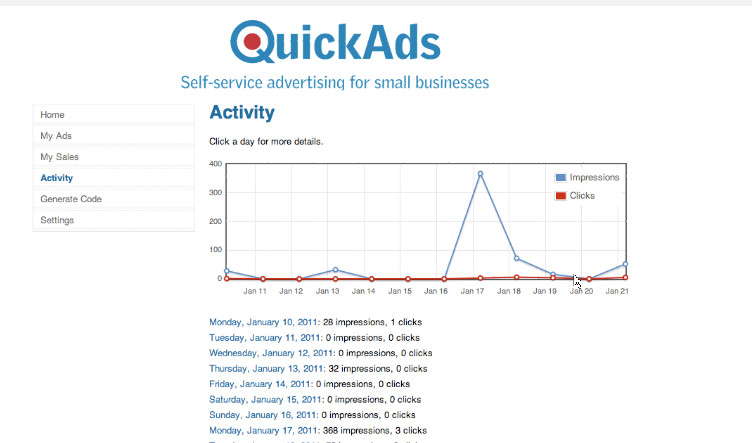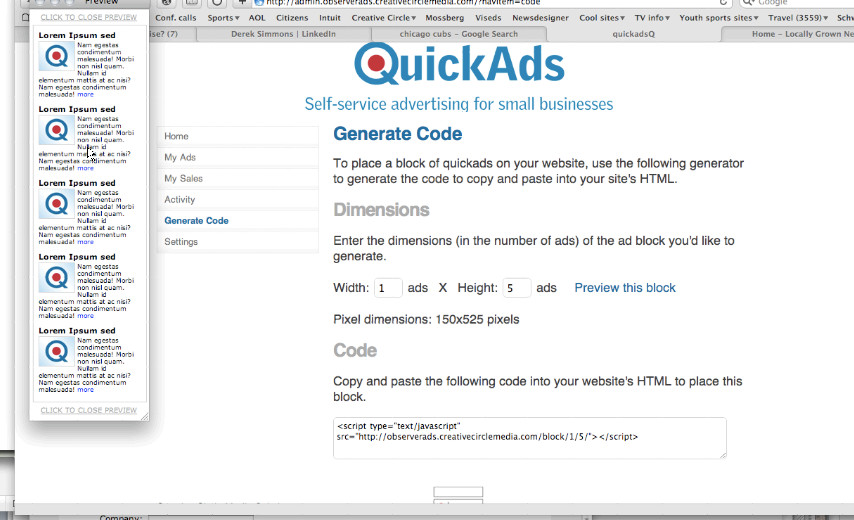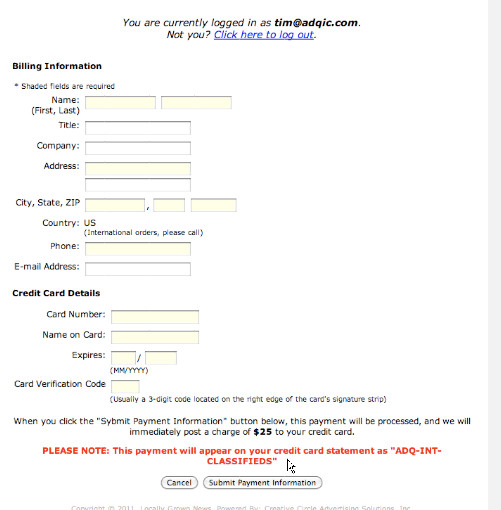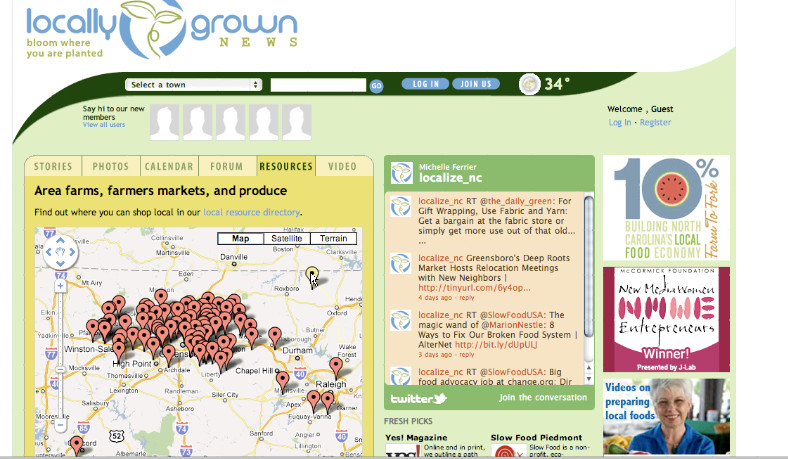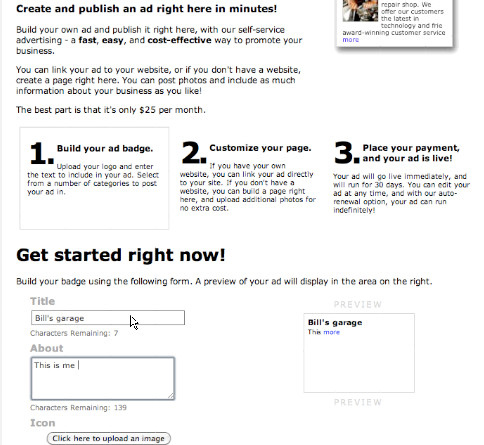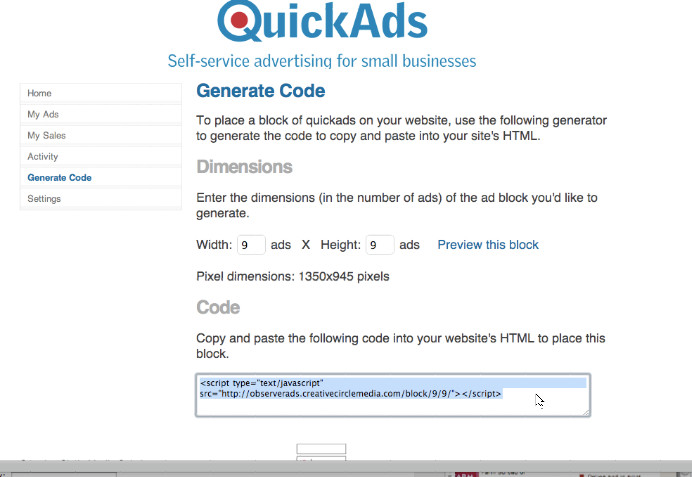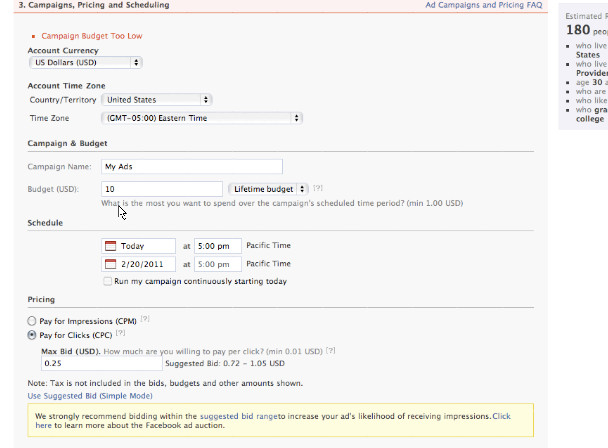QuickAds' self-serve text ad platform ideal for SMB's
Many large publishers are investigating self-serve ad platforms as a way to sell advertising to small businesses – and replace classifieds – efficiently. A new entry in this field is QuickAds, a just-released self-serve ad platform from Creative Circle Media Solutions.
Unlike self-serve display ads (think of Hearst's AdReady platform), QuickAds are simple text and logo units like Google AdWords. Small businesses can create the ads via a self-serve interface and select an area of the site via a drop down menu.
The ad units can link to a web page or a user-created landing page, whose URL positions advertisers to rise on the search engines – and helping media companies to compete with Google and directories.
The platform is almost overly simple; the units were created to compete with AdWords and Facebook text ads, but the model is aimed at the thousands of small businesses who don't understand how to participate in those national platforms. Local media already have the natural advantages of front facing traffic and intrinsic targeting, but the ace in the hole is simple pricing instead of algorithm-based auctions.
(Full disclosure: LocalMediaInsider is built on a CMS platform from Creative Circle, however, we have no financial interest in this product. We just like the simplicity.)
Bill Ostendorf, CEO of Creative Circle, says the platform capitalizes on the national platforms' key weakness.
"The fatal flaw of the Google platform and Facebook is the bidding process. No one understands it. A whole industry has sprung up to advise people about how much to bid and for what keywords... They didn't realize that simplicity sells.
"Even Gannett created a platform and copied Google. But no one was asking what Google did not do well," which is the overly complex keyword auction.
Still highly targeted text ads may become the most common way for small businesses to advertise in the future, due to the popularity of these units on Facebook, Google and now LinkedIn.
“Most publishers have no idea that you can place an ad on Facebook for males who are interested in sailing who live in Warwick, Rhode Island, and have a college degree. They can target your town. Your demographics. They are poised to eat us alive.
"And we're feeding them our content with a bunch of Facebook feeds. It's unbelievable. It's not unlike newspapers' paywall mistake. If we don't fix this, a few years from now people will be saying 'How can newspapers have been so blind -- again?'"
The QuickAds platform may be on to something obvious and not obvious, for the small business market, like the emporer having no clothes. Half of Facebook's $2 billion in revenue – about $1 billion or so - is coming from SMB's using its self-serve ad system. Google AdSense ads brought in more than $8 billion. The only obstacle causing churn is the wildly misunderstood bidding algorhythm.
QuickAds look like AdWords with a logo, but use a (suggested) pricing model of $30 a month on autorenew. Ads can be targeted by channel category, geographic zones on the site or events. Since many local sites already have these targets as ad zones, they don't always need a more sophisticated approach.
Currently QuickAds are live on one small site, locallygrownnews, and half dozen media sites will launch the platform in the next few weeks. The first newspaper to deploy the platform will be the Observer-Reporter in Washington County, Pa.
Each of the ads pops up into a landing page, also created with the same self-serve interface:
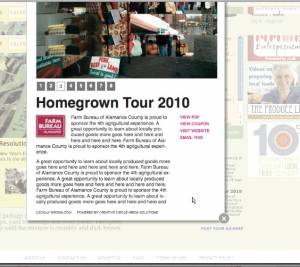
Landing pages (which each have a site URL for great SEO) can also be grouped together in channels, or the ads can be integrated on maps for hyper-local special sections. So they could be used find a doctor for a health and fitness guide, restaurants near an event, service providers during an emergency and so on (another example of a vertical target is in the images to the right, please click to enlarge). Here's a grouping of a category we've never seen on any site, anywhere:
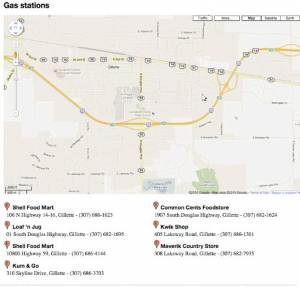
The backend interface for both advertisers and administrators (since our site is built on the same platform, we know the drill) is dirt simple. For a walk-through of the front and back end (user and administrator side) of placing and grouping an ad unit, click on images to the right, then click to enlarge.
Creative Circle is offering the platform for a fixed setup and hosting fee, a revenue share or a blend of both.
Our take: This is a great concept that understands "what local businesses want" on a solid platform. If anything, it's too boiled down, but for the small business market – and understaffed small media site administrators – that is probably a good thing.
There are a variety of things to like. Landing pages can be linked together to form channels and directory-style deployments (like gas stations, above) work well with guides. We especially like the idea of being able to sell SMB's on annual, auto-renewing "guides" as a way to trump (replace?) directories. Venue guides built on this platform can pack more revenue into channels like music, arts (happy hour guide, anyone?) and other misunderstood local verticals, from wineries to hunting and fishing areas.
There are also some nifty practical innovations for the administrative user: To pick the size and shape of the grouping to deploy, the administrator just types in the number of ads vertically and horizontally (third image on the right, click to enlarge). A production person can easily use this to fill in non-IAB size holes on site pages.
Ads can also be set to rotate through these shapes; so two-by-two grid which fits in a 250 by 300 cube can accomodate 10 or 20 ads, theoretically generating twice as much revenue from a high traffic page. And the code is automatically generated for a simple cut and paste to areas where ads are not serving. Neat.
The dashboard for SMB's to monitor and change ads is simple, and reports impressions and clicks, but not the gnat-sized CTR that flattens the hopes of new online advertisers.
Also, we like the big, self-serve landing page which can feature photos, PDFs and coupons – no video yet. Ostendorf's theory is that too many features will price SMB's out of the market again. He may be right, and if not video is certainly an easy add-on in the future.
"We could plug in dozens of additional features into QuickAds and we might add a few more. But the secret here was keeping it simple and cheap. As soon as QuickAds do everything, papers would have to charge more to keep them from canibalizing other ad forms. Then it all breaks down. QuickAds is targeting small advertisers who can't afford or don't want a lot of bells and whistles.
So if the banner ads perform slightly better; it's O.K. The text ads are at a lower price point. Some areas of the site, like maps around verticals, for example, lend themselves to text ads.
Finally, we like the way these ads combine forward facing advertising (the text and logo ad) with search power (the landing page built on the host site's URL). In competing against against a service like Google, IYP's, or Reply.com's PPL model, the forward facing aspect of the units gives these units an edge.

The author, Alisa Cromer is publisher of a variety of online media, including LocalMediaInsider and MediaExecsTech, developed while on a fellowship with the Reynolds Journalism Institute and which has evolved into a leading marketing company for media technology start-ups. In 2017 she founded Worldstir.com, an online magazine, to showcases perspectives from around the world on new topic each month, translated from and to the top five languages in the world.

